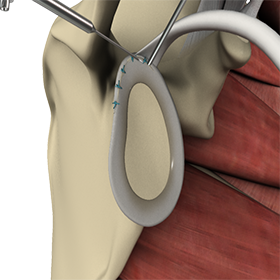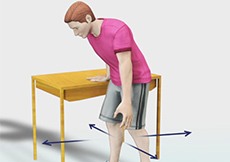- Anatomy
- Conditions
- Procedures
Rotator Cuff Repair

Rotator cuff repair is a surgery to repair an injured or torn rotator cuff. It is usually performed arthroscopically on an outpatient basis. An arthroscope, a small, fiber-optic instrument consisting of a lens, light source, and video camera. The camera projects images of the inside of the joint onto a large monitor, allowing your doctor to look for any damage, assess the type of injury and repair it. Large rotator cuff tears may require open surgery.
Shoulder Labrum Reconstruction

Traumatic injury to the shoulder or overuse of the shoulder by excessive throwing or weightlifting can cause a labral tear. In addition, the aging process may weaken the labrum, leading to injury secondary to wear and tear. A shoulder labral tear injury can cause symptoms such as pain, a catching or locking sensation, decreased range of motion and joint instability..
Shoulder Joint Replacement

Total shoulder replacement surgery is performed to relieve symptoms of severe shoulder pain and disability due to arthritis. In this surgery, the damaged articulating parts of the shoulder joint are removed and replaced with artificial prostheses. Replacement of both the humeral head and the socket is called a total shoulder replacement.
SLAP Repair

A SLAP repair is an arthroscopic shoulder procedure to treat a specific type of injury to the labrum called a SLAP tear. A SLAP repair is a minimally invasive surgery that uses an arthroscope, a tube with a light and camera on the end that projects images onto a monitor for your surgeon to view inside your joint.
Shoulder Arthroscopy

Arthroscopy is a minimally invasive diagnostic and surgical procedure performed for joint problems. Shoulder arthroscopy is performed using a pencil-sized instrument called an arthroscope. The arthroscope consists of a light system and camera that projects images of the surgical site onto a computer screen for your doctor to clearly view. Arthroscopy is used to treat disease conditions and injuries involving the bones, cartilage, tendons, ligaments, and muscles of the shoulder joint.
Shoulder Surgery

Shoulder surgery is a surgical procedure for the treatment of a shoulder injury or shoulder condition. The procedure involves repairing a diseased, damaged, or degenerated shoulder joint in order to eliminate pain and restore normal shoulder function. The shoulder is the most flexible joint in the body that enables a wide range of movements including forward flexion, abduction, adduction, external rotation, internal rotation, and 360-degree circumduction.
Shoulder Stabilization with Labral Repair

Shoulder instability is a chronic condition that causes frequent dislocation of the shoulder joint. A dislocation occurs when the end of the humerus (the ball portion) partially or completely dislocates from the glenoid (the socket portion) of the shoulder. A partial dislocation is referred to as a subluxation while a complete separation is referred to as a dislocation. The repeated dislocation of the humerus out of its socket is called chronic shoulder instability.
Open Shoulder Stabilization

Open shoulder stabilization is a surgical procedure performed to treat a condition called shoulder instability. Shoulder instability is a chronic condition that causes the frequent dislocation of the shoulder joint. A dislocation occurs when the end of the humerus (the ball portion) partially or completely dislocates from the glenoid (the socket portion) of the shoulder. A partial dislocation is referred to as a subluxation while a complete separation is referred to as a dislocation.
Pectoralis Major Tears/Repairs

The pectoralis muscle is a large fan-shaped muscle comprised of the pectoralis major and pectoralis minor muscles that stretch from the armpit to the collarbone and down across the lower chest region on both sides of the chest. The two sides of the chest connect at the breastbone or sternum. The pectoralis major is a powerful muscle that aids in rotating the arm inward and move it closer to the body.
Shoulder Fracture Care

A break in the bone that makes up the shoulder joint is called a shoulder fracture. The clavicle (collarbone) and end of the humerus (upper arm bone) closest to the shoulder are the bones that usually are fractured. The scapula, or shoulder blade, is not easily fractured because of its protective cover of surrounding muscles and chest tissue.
Periprosthetic Shoulder Fracture Fixation

A periprosthetic shoulder fracture is a fracture that occurs in the bone adjacent to a shoulder prosthesis.
Exercises for Shoulder Impingement Syndrome

Shoulder impingement syndrome is a common condition seen in athletes and individuals who perform a lot of overhead arm movements. This activity results in irritation of the rotator cuff tendon as it repeatedly rubs against the acromion, which is the bony process of the shoulder blade.
Intraarticular Shoulder Injection

The shoulder is prone to different kinds of injuries and inflammatory conditions. An intraarticular shoulder injection is a minimally invasive procedure to treat pain and improve shoulder movement. It may be performed with the help of ultrasound or fluoroscopic imaging which allows your physician to precisely target the intraarticular space.
Labral Debridement and Repair

Labral debridement and repair is a surgical procedure to remove loose and damaged cartilage in the labrum and to secure the torn labrum to its normal attachment to the bone.
Anterior Shoulder Stabilization

Anterior shoulder stabilization is a surgical procedure performed to treat a condition called anterior shoulder instability. Anterior shoulder instability, also known as anterior glenohumeral instability, is a shoulder condition in which damage to the soft tissues or bone causes the head of the humerus (upper arm bone) to dislocate or sublux from the glenoid fossa, compromising the function of the shoulder.
Posterior Shoulder Stabilization

Posterior shoulder stabilisation is a surgical procedure performed for the treatment of a condition called posterior shoulder instability. Posterior shoulder instability, also known as posterior glenohumeral instability, is a condition in which the head of the humerus (upper arm bone) dislocates or subluxes posteriorly from the glenoid (socket portion of the shoulder) as a result of significant trauma, compromising shoulder function.
AC Joint Stabilization

Acromioclavicular (AC) joint stabilization is a surgical procedure employed to treat severe cases of AC joint dislocation. AC joint dislocation is the separation of the collar bone or clavicle from the acromion (the top portion of the shoulder blade or scapula at the outer edge of the shoulder) due to severe trauma. AC joint dislocation usually occurs as a result of a direct fall on to the top of the shoulder which causes the shoulder blade to be forced downwards and the collarbone to pop up.
Sternoclavicular Joint Reconstruction

Sternoclavicular joint reconstruction is a surgical procedure employed to repair and restore full function of a damaged sternoclavicular joint. The sternoclavicular (SC) joint is the joint between the breastbone (sternum) and the collar bone (clavicle). Injuries to this joint are called sternoclavicular joint injuries and can include stretching or tearing of the ligaments.






